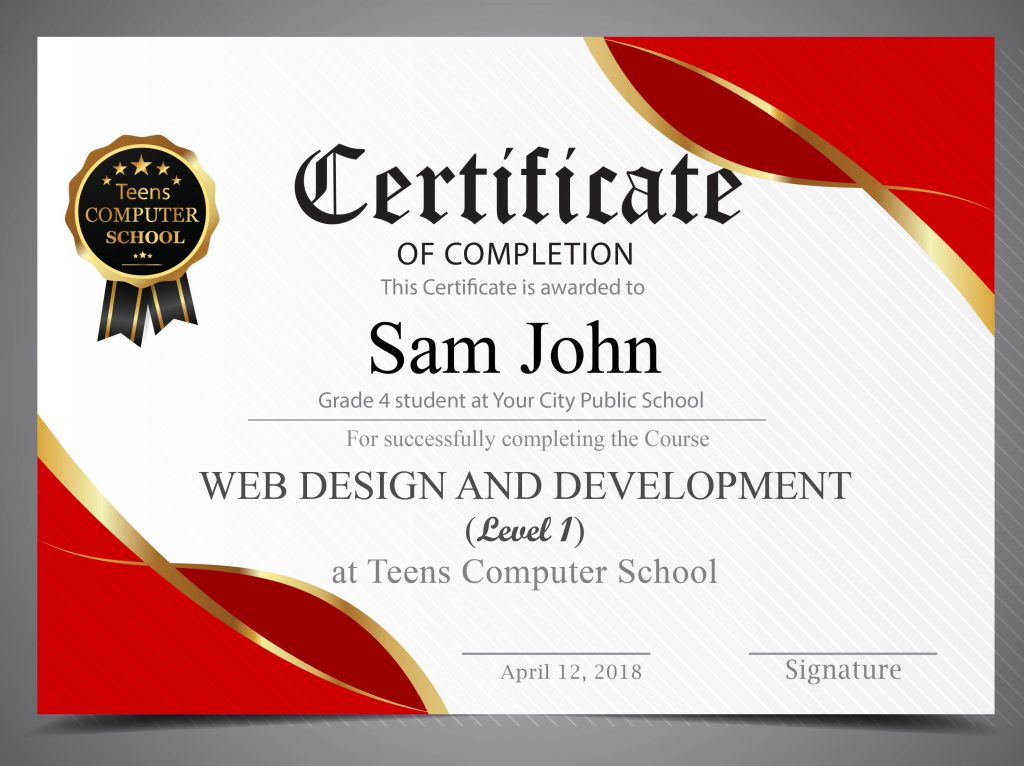Web Design and development online courses
During this course, students will learn how to design the entire Website using HTML and CSS, Adobe Dreamweaver and WordPress for Web design and Development. Students will learn how to set up an FTP connection and upload files on the hosting server.
Our Instructor will teach students how to design beautiful, responsive, and intuitive websites with HTML, CSS and JavaScript and using WordPress content management technology. Great web design is the difference between attracting and losing customers. A great online experience is essential for budding any businesses, and an exciting opportunity for future Web designers in a job market.
Web Design and development course
Who this course is for:
This course is for teens who love computers and are interested in computers and Web Design and want to create their own WebSite.
This course does not require any level of computer knowledge and will be interesting to newcomers as to “experiences” teens.
Requirements:
School students from 13 to 18 years old.
Students must have a laptop with Windows operation system and Internet connection.
Start time:
Web Design and development course start every Month
The number of students:
6 – 8 students per class.
1:6 ratio
1:6 ratio Teacher to Student ratio, or better. All instructors are police-checked, triple-reference checked, and highly trained.
Certificate of Course Completion
We provide Certificates of completion for students that complete our 40 lessons courses.
Upon completion of a Web Design and Development online course, a Certificate will be issued. A course completion certificate says you have attended all the classes required, pass all the tests required, and handed in all the work required.

SPOTS AVAILABLE
In this Web design and Development course students will learn:

MODULE 1
Color in Web. Color Combinations
In this module, students will learn about the color wheel, color theory, and how to use it for Web Design!
MODULE 2
Design.
8 Principles of Good Website Design.The success of any website entirely depends on how its web design is. Learn these principles to help make your website the best design it can be.
MODULE 3
Hosting. How does it work? Paid and Free Hosting
Aweb hosting service is a type of Internet hosting service that allows individuals and organizations to make their website accessible via the World Wide Web. Web hosts are companies that provide space on a server owned or leased for use by clients, as well as providing Internet connectivity, typically in a data center. Web hosts can also provide data center space and connectivity to the Internet for other servers located in their data center, called colocation, also known as Housing in Latin America or France.In this module, students will learn about different types of hosting and hosting services and study how to use these services for own Web Site.
MODULE 4
Registering your domain name
R egistering a domain name gets you an official address for your web site on the World Wide Web. With this ‘official’ address, the rest of the web can find you. Like your home address is unique in the real world, there also can’t be any duplicate addresses on the Internet, otherwise, no one would know where to go! In other words, domain names are unique addresses on the web.In this module, students learn how to choose a name for their Web site using special Internet services. Students also figure out how the Web site name will effect web site indexing. In other words, which name to choose to make the site easier to find on the Internet.
Sign up now for online course
MODULE 5
HTML
H ypertext Markup Language (HTML) is the standard markup language for documents designed to be displayed in a web browser. It can be assisted by technologies such as Cascading Style Sheets (CSS) and scripting languages such as JavaScript. Web browsers receive HTML documents from a web server or from local storage and render the documents into multimedia web pages. HTML describes the structure of a web page semantically and originally included cues for the appearance of the document.
HTML elements are the building blocks of HTML pages. With HTML constructs, images and other objects such as interactive forms may be embedded into the rendered page.
In this HTML module course will show anyone (even a total beginner) how to build their first website and learn to code HTML
MODULE 5
WordPress
W ordPress (WordPress.org) is a content management system (CMS) based on PHP and MySQL that is usually used with the MySQL or MariaDB database servers but can also use the SQLite database engine. Features include a plugin architecture and a template system, referred to inside WordPress as Themes. WordPress is most associated with blogging (its original purpose when first created) but has evolved to support other types of web content including more traditional mailing lists and forums, media galleries, membership sites, learning management systems (LMS) and online stores. WordPress is used by more than 60 million websites, including 33.6% of the top 10 million websites as of April 2019, WordPress is one of the most popular content management system (CMS) solutions in use.
MODULE 6
Software and Tools for Web Design
T his Module one of the most important in our course. This a guide to show you that YOU CAN create your own website, YOU CAN edit content, add images, amend files via FTP. With the help of some free and paid web design software and tools, you can do anything when it comes to web development and design. You CAN build the best website!Sign up now for online course
Course curriculum in details:
The Web Development Process
Files and Folders
Editing Code
HTML Tags
Overview of HTML Tags
The HTML 5 Template
The Head
Formatting Content
The Coding Cycle
Compound Tags
Character Entities
Commenting and Formatting Code
Other HTML Tags
HTML Attributes and Images
Acquiring Images
Graphics File Formats
Editing Images
The img Tag
Absolute Links
Embedding Media
Relative Links
Validating Code
CSS Basics, Colors and Inline Styles
Internal Style Sheets and Basic Formatting
External Stylesheets
Common Properties
Creating Effective Color Palettes
CSS – Page Layout
Classes IDs Divs Spans
The Box
Boxes in Boxes
Whitespace and Paragraph Formatting
Styling Page Divisions
Designing with Sections
Favicons
Sections and Background Colors
Background Images
Adding a Navigation Bar
Typography
Setting up WordPress
Creating Posts
CMS Security
Creating Pages
Working with Media
Themes and Widgets
SPOTS AVAILABLE
TUITION & STUDY OPTIONS
Choose that better suits your needs:
Online course using Live Stream Webinar Technology.
You can start classes at any
1 lesson per week. Each lesson for 1 hour.
Tuition fee:
$49.00 per week (Monthly payments)
$39.00 per week. (If you pay for at least three months of training in one payment)
Space is still available 6-7 spots left Registration
How our online class works
Students unfamiliar with distance learning can ask themselves: “How do online classes work?” Classes are held online as in the classroom, just students do not need to spend time on the road. In addition, they have no problems, study on the course, which is not in the nearest college or even in their country.
Study course materials
As in a regular classroom, your Graphic Design Course begins by viewing a slide presentation or by watching a video leсture or by listening to a lecture and / or reading lecture materials in an Internet textbook.
Students should also be prepared for a list of reading materials for Each Month of the course. To test the level of knowledge of thous materials students regularly perform online tests and quizzes.
What time do I need to study online?
Depending on the course, students may need to listen to a course lecture and do some assessments every second day, or only once or twice a week. As in any other class, students should take notes in their notebooks as they study the learning material.
Course assessments
Students should complete most of the assessments at home, at a convenient time. Students will have to complete a certain number of tasks for each month of the course. Most courses combine shorter assessments with larger long-term assessments (projects) to be completed at the end of the Month or semester.
Participation in the discussion.
Nearly all online colleges require students to take part in weekly or by-weekly webinars or discussions about the next course topic or home assessments with the rest of the class, course instructor or both. This may mean posting discussions on the online discussion board or participating in group chats on a specific date and time.
Students can ask any questions to their instructor or discuss a complex topic with students in their group. This may vary depending on the course and the specifics of a particular course topic. Listening to audio lectures, browsing course materials, viewing video lectures, doing homework and talking with students in your group is not that different from a traditional lesson.
In fact, the experience of most students with online education is very similar to attending courses on campus. If you have any questions about the details of online education, contact the college administration or ask a question here.
Sign up now for online courseOnline Learning at a Glance
ONLINE SPOTS AVAILABLE







